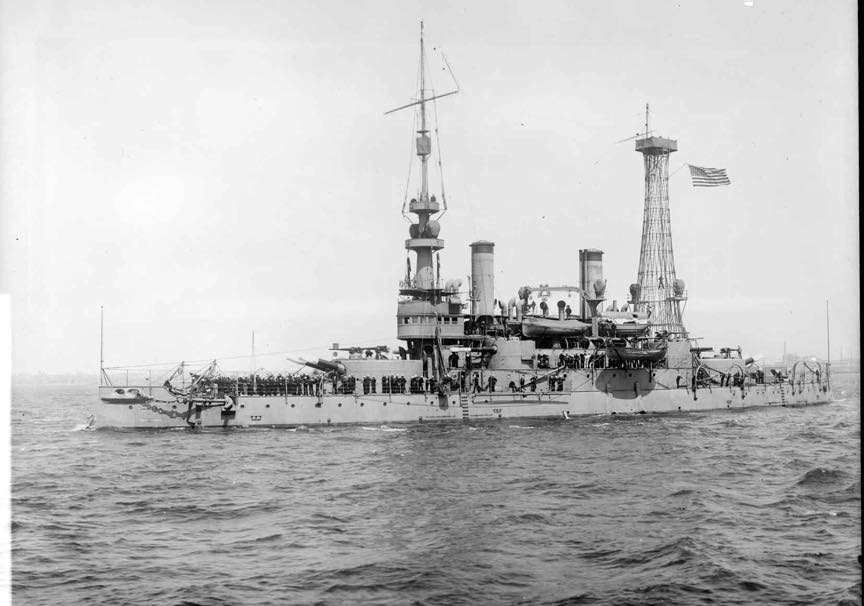USS Massachusetts BB-2

"(BB-2: displacement 10,288; length 350'11"; beam 69'3"; draft 24'; speed 16.21 knots; complement 586; armament 4 13-inch guns, 8 8-inch guns, 4 6-inch guns, 2 3-inch guns, 20 6-pounders, 6 1-pounders, 6 18-inch torpedo tubes; class Indiana)
The fourth USS Massachusetts (BB-2) was laid down by William Cramp & Sons in Philadelphia, Pennsylvania, on June 25, 1891. It was launched on June 10, 1893, sponsored by Miss Leila Herbert, daughter of the Secretary of the Navy Hilary Herbert, and commissioned on June 10, 1896, with Captain Frederick Rodgers in command.
Setting sail for shakedown on August 4, 1896, Massachusetts conducted trials and maneuvers off the middle Atlantic coast until November 30, when she entered the New York Navy Yard for an overhaul. After a brief voyage to Charleston, South Carolina, from February 12 to 20, 1897, the battleship departed New York on May 26 for Boston, arriving two days later. There, a celebration was held in her honor, including the presentation of the Massachusetts Coat of Arms on June 16, and a gift of a Victory statue the next day. She left Boston on June 15 to cruise to St. Johns, Newfoundland, arriving on June 23. Departing on June 28, the warship operated off the Atlantic coast for the next ten months, participating in training maneuvers with the North Atlantic Squadron off Florida and visiting major East Coast ports. On March 27, 1898, she was ordered to Hampton Roads, Virginia, to join the "Flying Squadron" for the blockade of Cuba.
Massachusetts departed Norfolk on May 13 for Cienfuegos, Cuba, and began blockade duties on May 22. On the afternoon of May 31, she, along with the battleship Iowa (BB-4) and cruiser New Orleans, bombarded forts at the entrance to Santiago de Cuba, and exchanged fire with the Spanish cruiser Cristobal Colon, forcing the enemy ship to retreat into Santiago's inner harbor. The battleship remained on patrol off Santiago, intermittently bombarding Spanish fortifications until July 3, when she left to coal at Guantanamo Bay. Missing the Battle of Santiago, she returned to her station on July 4, arriving in time to assist the battleship Texas in forcing the cruiser Reina Mercedes to beach and surrender at midnight on July 6. After supporting the American occupation of Puerto Rico from July 21 to August 1, Massachusetts returned to New York, arriving on August 20.
Over the next seven years, Massachusetts cruised the Atlantic coast and the eastern Caribbean as a member of the North Atlantic Squadron. From May 27 to August 30, 1904, she served as a training ship for Naval Academy midshipmen off New England, then entered the New York Yard for an overhaul. Departing New York on January 13, 1905, she steamed for the Caribbean for training maneuvers and returned north to cruise off New England in May. Entering New York on November 12, 1905, she underwent an inactivation overhaul and decommissioned on January 8, 1906.
The battleship was placed in reduced commission on May 2, 1910, to serve as a summer practice ship for Naval Academy midshipmen. Over the next four years, she made three midshipman cruises—twice to Western Europe—before joining the Atlantic Reserve Fleet in September 1912. After a brief voyage to New York from October 5 to 16 for the Presidential Fleet Review, the warship returned to Philadelphia, where she remained until decommissioning on May 23, 1914.
Massachusetts was recommissioned on June 9, 1917, in Philadelphia. Sailing on October 9, she arrived at the Naval Training Station in Newport, Rhode Island, the same day, where she embarked Naval Reserve gun crews for gunnery training in Block Island Sound. Continuing this duty until May 27, 1918, the old battleship then underwent repairs at the Philadelphia Navy Yard. Assigned to battle practice, "A" Division, Battleship Force 1, Atlantic Fleet, on June 9, 1918, she steamed to Yorktown, Virginia, the same day. For the remainder of World War I, she served as a heavy gun target practice ship in Chesapeake Bay and local Atlantic waters. Massachusetts returned to Philadelphia on February 16, 1919. Redesignated Coast Battleship No. 2 on March 29, she was decommissioned for the final time on March 31. Struck from the Navy list on November 22, 1920, she was loaned to the War Department as a target ship. After being scuttled off Pensacola Bar, Florida, on January 6, 1921, the hulk was bombarded by batteries from Fort Pickens for four years before being returned to the Navy on February 20, 1925. Though offered for sale for scrap, no acceptable bids were received, and finally, on November 15, 1956, the ship was declared the property of the state of Florida
 >
>